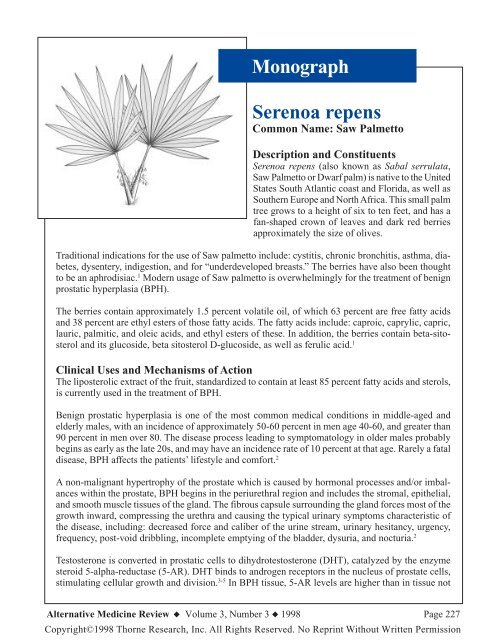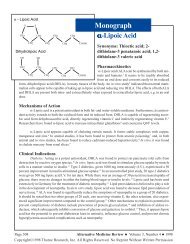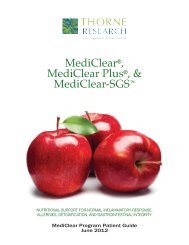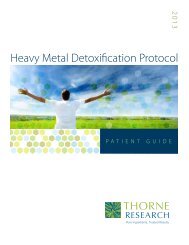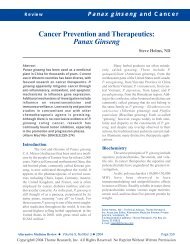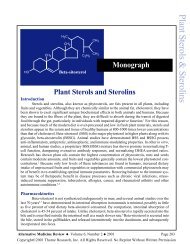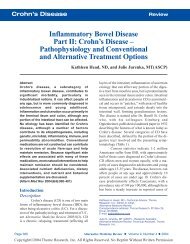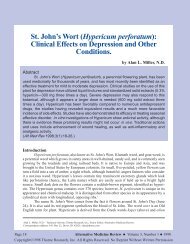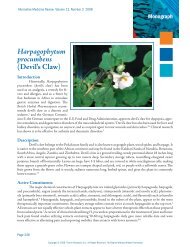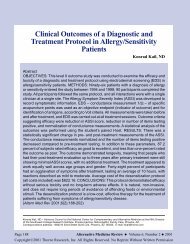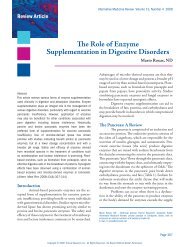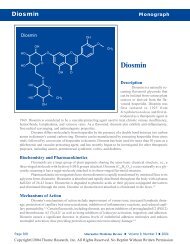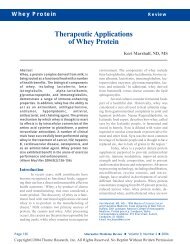Monograph Serenoa Repens - Thorne Research
Monograph Serenoa Repens - Thorne Research
Monograph Serenoa Repens - Thorne Research
Create successful ePaper yourself
Turn your PDF publications into a flip-book with our unique Google optimized e-Paper software.
<strong>Monograph</strong><br />
<strong>Serenoa</strong> repens<br />
Common Name: Saw Palmetto<br />
Description and Constituents<br />
<strong>Serenoa</strong> repens (also known as Sabal serrulata,<br />
Saw Palmetto or Dwarf palm) is native to the United<br />
States South Atlantic coast and Florida, as well as<br />
Southern Europe and North Africa. This small palm<br />
tree grows to a height of six to ten feet, and has a<br />
fan-shaped crown of leaves and dark red berries<br />
approximately the size of olives.<br />
Traditional indications for the use of Saw palmetto include: cystitis, chronic bronchitis, asthma, diabetes,<br />
dysentery, indigestion, and for “underdeveloped breasts.” The berries have also been thought<br />
to be an aphrodisiac. 1 Modern usage of Saw palmetto is overwhelmingly for the treatment of benign<br />
prostatic hyperplasia (BPH).<br />
The berries contain approximately 1.5 percent volatile oil, of which 63 percent are free fatty acids<br />
and 38 percent are ethyl esters of those fatty acids. The fatty acids include: caproic, caprylic, capric,<br />
lauric, palmitic, and oleic acids, and ethyl esters of these. In addition, the berries contain beta-sitosterol<br />
and its glucoside, beta sitosterol D-glucoside, as well as ferulic acid. 1<br />
Clinical Uses and Mechanisms of Action<br />
The liposterolic extract of the fruit, standardized to contain at least 85 percent fatty acids and sterols,<br />
is currently used in the treatment of BPH.<br />
Benign prostatic hyperplasia is one of the most common medical conditions in middle-aged and<br />
elderly males, with an incidence of approximately 50-60 percent in men age 40-60, and greater than<br />
90 percent in men over 80. The disease process leading to symptomatology in older males probably<br />
begins as early as the late 20s, and may have an incidence rate of 10 percent at that age. Rarely a fatal<br />
disease, BPH affects the patients’ lifestyle and comfort. 2<br />
A non-malignant hypertrophy of the prostate which is caused by hormonal processes and/or imbalances<br />
within the prostate, BPH begins in the periurethral region and includes the stromal, epithelial,<br />
and smooth muscle tissues of the gland. The fibrous capsule surrounding the gland forces most of the<br />
growth inward, compressing the urethra and causing the typical urinary symptoms characteristic of<br />
the disease, including: decreased force and caliber of the urine stream, urinary hesitancy, urgency,<br />
frequency, post-void dribbling, incomplete emptying of the bladder, dysuria, and nocturia. 2<br />
Testosterone is converted in prostatic cells to dihydrotestosterone (DHT), catalyzed by the enzyme<br />
steroid 5-alpha-reductase (5-AR). DHT binds to androgen receptors in the nucleus of prostate cells,<br />
stimulating cellular growth and division. 3-5 In BPH tissue, 5-AR levels are higher than in tissue not<br />
Alternative Medicine Review ◆ Volume 3, Number 3 ◆ 1998 Page 227<br />
Copyright©1998 <strong>Thorne</strong> <strong>Research</strong>, Inc. All Rights Reserved. No Reprint Without Written Permission
affected by BPH. 4,5 The presence of DHT may also stimulate 5-AR activity, causing a positive feedback<br />
loop, and more DHT. 6 The standardized liposterolic <strong>Serenoa</strong> extract has been found to be a<br />
potent inhibitor of 5-AR, resulting in decreased tissue DHT. <strong>Serenoa</strong> also competitively inhibits<br />
binding of testosterone and DHT to cytosolic and nuclear androgen receptors. 7-9<br />
Another component of BPH is inflammation within the prostate gland. A standardized <strong>Serenoa</strong> extract<br />
has been shown to inhibit 5-lipoxygenase and thus the downstream pro-inflammatory arachidonic<br />
acid metabolites leukotriene B4 (LTB4) and 5-hydroxyeicosatetraenoic acid (5-HETE). 10<br />
Clinical Studies<br />
In a double-blind, placebo-controlled study of 110 BPH patients, 160 mg twice per day of a standardized<br />
<strong>Serenoa</strong> extract significantly improved nocturia, dysuria, post-voiding residual urine, flow rate,<br />
patient self-rating, and the physician’s overall assessment. 11 In another double-blind clinical study,<br />
urinary symptoms and flow rates were significantly improved in 42.9 percent of patients taking a<br />
<strong>Serenoa</strong> extract, versus 15.4 percent of patients given placebo. 12 In an open trial, 67 percent of patients<br />
on <strong>Serenoa</strong> described their subjective symptom relief as “excellent”, while 25 percent characterized<br />
their relief as “good”. 13 No side effects or toxicity were noted.<br />
The standard pharmaceutical therapy for BPH is the drug Proscar ® (finasteride), a 5-AR inhibitor. A<br />
six-month, double-blind study of 1,098 BPH patients over 50 years of age compared Proscar (5 mg<br />
per day) with a standardized <strong>Serenoa</strong> extract (160 mg twice per day). Both treatments decreased BPH<br />
symptoms equally, and improved quality of life. Even though both treatments significantly improved<br />
symptomatology, it is interesting to note that Proscar reduced prostate size by 18 percent and the<br />
<strong>Serenoa</strong> extract reduced it six percent. 14<br />
Dosage<br />
The dose of the standardized liposterolic <strong>Serenoa</strong> extract (85 - 95% fatty acids and sterols) used in the<br />
majority of clinical studies on BPH is 160 mg twice per day. Clinical results may be seen in six to<br />
eight weeks, although a six-month trial is the minimum to assess clinical efficacy.<br />
Toxicology<br />
There are no known cases of toxicity. Occasionally, patients experience minor gastrointestinal symptoms<br />
(nausea, abdominal pain). 15<br />
References<br />
1. Duke JA. Handbook of Medicinal Herbs. Boca Raton, FL: CRC Press; 1985:443.<br />
2. Miller AL. Benign prostatic hyperplasia: nutritional and botanical therapeutic options. Altern Med Rev<br />
1996;1:18-25.<br />
3. McConnell JD, Barry MJ, Bruskewitz RC, et al. Benign prostatic hyperplasia: diagnosis and treatment. Clinical<br />
practice guideline #8. AHCPR Publication no. 94-0582. Rockville, MD: Agency For Health Policy and<br />
<strong>Research</strong>, Public Health Service, U.S. Department of Health and Human Services. February 1994.<br />
4. Metcalf BW, Levy MA, Holt DA. Inhibitors of steroid 5 alpha-reductase in benign prostatic hyperplasia, male<br />
pattern baldness and acne. Trends Pharmacol Sci 1989;10:491-495.<br />
Page 228 Alternative Medicine Review ◆ Volume 3, Number 3 ◆ 1998<br />
Copyright©1998 <strong>Thorne</strong> <strong>Research</strong>, Inc. All Rights Reserved. No Reprint Without Written Permission
5. Tenover J. Prostates, pates, and pimples. The potential medical uses of steroid 5-alpha-reductase inhibitors.<br />
Endocrinol Metab Clin North Amer 1991;20:893-909.<br />
6. George FW, Russell DW, Wilson JD. Feed-forward control of prostate growth: Dihydrotestosterone induces<br />
expression of its own biosynthetic enzyme, steroid 5-alpha-reductase. Proc Natl Acad Sci 1991;88:8044-8047.<br />
7. Sultan C, Terraza A, Devillier C, et al. Inhibition of androgen metabolism and binding by a liposterolic extract<br />
of “<strong>Serenoa</strong> repens B” in human foreskin fibroblasts. J Steroid Biochem 1984;20:515-519.<br />
8. Carilla E, Briley M, Fauran F, et al. Binding of Permixon, a new treatment for prostatic benign hyperplasia, to<br />
the cytosolic receptor in the rat prostate. J Steroid Biochem 1984;20:521-523.<br />
9. Magdy El-Sheikh M, Dakkak MR, Saddique A. The effect of Permixon on androgen receptors. Acta Obstet<br />
Gynecol Scand 1988;67:397-399.<br />
10. Paubert-Braquet M, Mencia Huerta JM, Cousse H, Braquet P. Effect of the lipidosterolic extract of <strong>Serenoa</strong><br />
repens (Permixon) on the ionophore A23187-stimulated production of leukotriene B4 (LTB4) from human<br />
polymorphonuclear neutrophils. Prostaglandins Leukot Essent Fatty Acids 1997;57:299-304.<br />
11. Champault G, Patel JC, Bonnard AM. A double-blind trial of an extract of the plant <strong>Serenoa</strong> repens in benign<br />
prostatic hyperplasia. Br J Pharmac 1984:461-462.<br />
12. Tasca A, Brulli M, Cavazzana A, et al. Treatment of the obstructive symptomatology of prostatic adenoma using<br />
an extract of <strong>Serenoa</strong> repens: a double-blind clinical study vs. placebo. Min Urol Nefrol 1985;37:87-91.<br />
13. Carreras JO. Novel treatment with a hexane extract of <strong>Serenoa</strong> repens in the treatment of benign prostatic<br />
hypertrophy. Arch Esp de Urol 1987;40:310-313.<br />
14. Carraro JC, Raynaud JP, Koch G, et al. Comparison of phytotherapy (Permixon ® ) with finasteride in the<br />
treatment of benign prostatic hyperplasia; A randomized international study of 1,098 patients. Prostate<br />
1996;29:231-240.<br />
15. American Herbal Product Association’s Botanical Safety Handbook. McGuffin M, Hobbs C, Upton R, Goldberg<br />
A, eds. Boca Raton, FL: CRC Press; 1997:107.<br />
Alternative Medicine Review ◆ Volume 3, Number 3 ◆ 1998 Page 229<br />
Copyright©1998 <strong>Thorne</strong> <strong>Research</strong>, Inc. All Rights Reserved. No Reprint Without Written Permission


